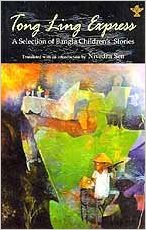A translation of Bangla children’s stories? My first reaction was one of excitement at the authors featured— Sukumar Ray, Lila Majumdar, Shibram Chakrabarty, Ashapurna Debi…a child’s staple diet when we were growing up in Calcutta. We would wait eagerly for the weekly and monthly periodicals—Suktara, Sandesh and a few others that slip my mind that serialized their stories for children. At last I thought, I could share with my children the treasure-trove of literature that existed in Bengali, brought up as they are on Harry Potter, Roald Dahl and a strange character called Captain Underpants. Enid Blyton is passe now.
My second reaction though was one of confusion. Who was this book for? Adults? Students of literature, researching the psyche of children’s tales? Or for children to discover the magic of regional literature that is steeped deep in our cultural norms and traditions?
The long-winded introduction, exploring the Bengali child’s personal space, essentially the protagonist of such tales, leads to some amount of fatigue and flagging interest. What pray does this mean?—‘The Bakhtinian adventure chronotype, applied to middle class Bengali child protagonists, offers him a release from anxieties about incarceration within domestic spaces and a rigid work discipline. The very notion of adventure becomes a credo or way of life.’ One would think, why just the Bengali child? Aren’t all children, in all children’s tales, all over the world, looking for escape through flights of fancy? And thereby hangs the tale?
Indeed, one would have really appreciated it if the introduction had devoted some space and time to the celebrated authors of these stories, who ushered in a new genre of storytelling in the 19th and early 20th centuries. Till then, literature for children was populated by kings and queens, wicked stepmothers, monsters and demons, flying horses and bloodthirsty vampires, much as it was the world over and popularly known as Grandmother’s Bag of Stories (Thakurmar Jhuli), captured in print from the oral tradition.
And then came the pioneers of a new era, most certainly beginning with Upendra Kishore Roychowdhury. The legacy was carried on by his son Sukumar Ray, the father of nonsense verse in Bengali, perhaps Indian literature; the creator of characters such as the wildly funny and selectively eccentric Pagla Dashu (Mad Dashu) and the series of hybrid animals like the Kumropotash, Ram Gorurer Chhana and Tyanshgoru of Abol Tabol, which defy description by this writer. Then came Sibram Chakraborty, his clever use of puns and the popular characters Harshabardhan – Gobardhan that he created. Authors such as Bibhuti Bhushan Bandopadhyay with his classic Chander Pahar or Narayan Gangopadhyay’s timelss character Teni-da and Satyajit Ray’s Feluda carried on the tradition of combining Bengali intellectualism with contemporary middle-class sensibilities to produce literature that held children of that era in thrall.
The two women authors presented in this compilation need no introduction where Bengali modern literature is concerned, whether for children or adults. Lila Majumdar’s children’s books such as Padi Pishir Barmi Baksho, Din Dupurey or Haldey Pakhir Palak are undeniably among the best fantasy, adventure and ghost stories in Bengal. Being Sukumar Ray’s niece, she had undoubtedly inherited the family penchant for an unbridled imagination coupled with a zany sense of humour. The three stories by her featured here—Guptadhan (Hidden Treasure), Ghoton Kothay (Where is Ghoton?) and Guper Guptadhan (Gupe’s Buried Fortune) bear ample testimony to that. Self-educated, Ashapurna Devi broke all the shackles of a conservative family where the girl child didn’t go to school to become one of Bengal’s legendary women writers, her novels populated with strong women characters. The author of 62 children’s books, of the two stories featured here, the first Tai Jonnyei To (That is Why) is naturally about the girl child, a departure from the generally boy-centric literature of the times. Could the girl child indulge in fantasy? Of course she could is what Ashapurna Devi establishes with this story. A license for all girl children to dream.
There is undeniably a lot more that can be said about children’s literature in Bangla, but reviewing the stories featured here would be close to audacity on the part of this writer. Therefore one would now prefer to come back to the compilation itself and its production. While the effort is commendable, indicative of Sen’s knowledge, experience and insights into her subject, one wishes that the translations could have been less pedantic and literal so as to appear more attractive to today’s child. An archaic literary style runs like an anachronism through the book. The illustrations leave a lot to be desired, a pity since Sukumar Ray’s fabulous sketches have remained an all-time favourite with children. The cover jacket painting by Pradip Sengupta deserves mention though, very subtly capturing the make-believe world of magic realism that a child lives in.
Nevertheless such works are needed and welcome in order to carry on with the legacy of the illustrious authors featured here. Sahitya Akademi needs to be thanked on that count. However, one has to move with the times and present it in a way which is attractive, endearing and enduring. I therefore return with my question—who is this selection intended for?

